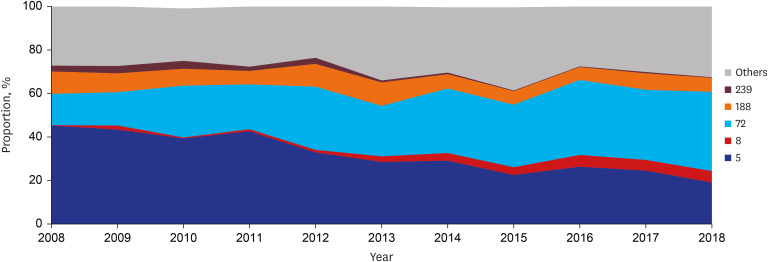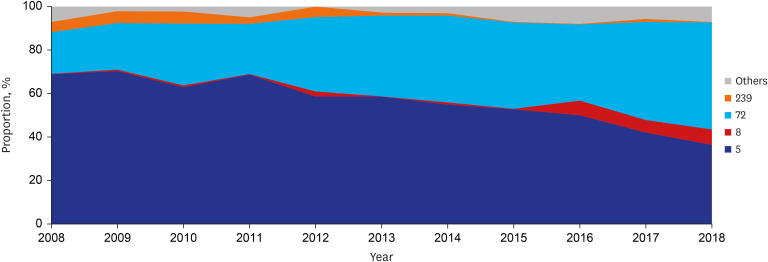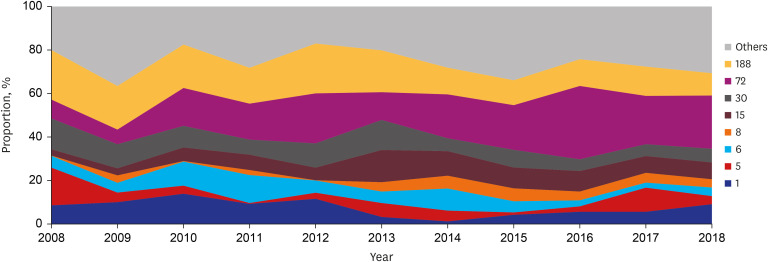J Korean Med Sci.
2021 Apr;36(16):e104. 10.3346/jkms.2021.36.e104.
A Longitudinal Study of Adult Patients with Staphylococcus aureus Bacteremia over 11 Years in Korea
- Affiliations
-
- 1Division of Infectious Diseases, Department of Internal Medicine, Chung-Ang University Hospital, ChungAng University College of Medicine, Seoul, Korea
- 2Division of Infectious Diseases, Asan Medical Center, University of Ulsan College of Medicine, Seoul, Korea
- 3Asan Institute of Life Sciences, Asan Medical Center, Seoul, Korea
- 4Center for Antimicrobial Resistance and Microbial Genetics, University of Ulsan, Seoul, Korea
- KMID: 2515085
- DOI: http://doi.org/10.3346/jkms.2021.36.e104
Abstract
- Background
The temporal changes in the Staphylococcus aureus genotypes causing S. aureus bacteremia (SAB) and the corresponding clinical changes over the last decade in South Korea are rarely investigated.
Methods
A longitudinal study of adult SAB patients was conducted in a large referral hospital in Seoul, South Korea. Adult monomicrobial SAB patients were enrolled between August 2008 and December 2018. Genotyping was performed by multilocus sequence typing (MLST) and staphylococcal protein A (spa) typing. Trends in changes were identified by linear regression analysis.
Results
Of 1782 adult SAB patients, the blood isolates of 1,778 (99.8%) and 1,634 (91.7%) were determined to be MLST and spa type, respectively. ST5 (–2.626%/year) and ST239 (–0.354%/year) decreased during the study period (P < 0.001 for both), but ST72 (2.009%/ yr)-and ST8 (0.567%/yr) increased (P < 0.001 for both). The most common genotype was changed from ST5 in 2008 (44.9%) to ST72 in 2018 (36.3%). Panton-Valentine leukocidinpositive spa-t008-MRSA (USA300) was found in 28.6%. Central venous catheter (CVC)-related SAB (–2.440%/yr) and persistent SAB (–1.016%/yr) decreased, but mortality and recurrence rates were unchanged.
Conclusion
Over the last decade, the hospital clones ST5 and ST239 have been replaced by community genotype ST72. This was associated with decreased CVC-related and persistent SAB. Increased USA300 was observed in community and hospital settings. Further research is required to identify the reasons for the ST72 epidemic and predict the impending epidemic of ST8 strains, including USA300.
Figure
Cited by 1 articles
-
Evaluation of Vancomycin TDM Strategies: Prediction and Prevention of Kidney Injuries Based on Vancomycin TDM Results
Byungwook Kim, Sejung Hwang, Eunjeong Heo, Hyung-sook Kim, Jongtak Jung, Eu Suk Kim, Hong Bin Kim, Kyunghoon Lee, Jeong Su Park, Junghan Song, Joon Hee Lee, Jae-Yong Chung, Kyoung-Ho Song, Seonghae Yoon
J Korean Med Sci. 2023;38(14):e101. doi: 10.3346/jkms.2023.38.e101.
Reference
-
1. Holland TL, Fowler VG Jr. Epidemiology of Staphylococcus aureus bacteremia in adults. Updated 2019. Accessed November 24, 2019. https://www.uptodate.com.2. Lakhundi S, Zhang K. Methicillin-resistant Staphylococcus aureus: molecular characterization, evolution, and epidemiology. Clin Microbiol Rev. 2018; 31(4):e00020–18. PMID: 30209034.
Article3. Kirby WM. Extraction of a highly potent penicillin inactivator from penicillin resistant staphylococci. Science. 1944; 99(2579):452–453. PMID: 17798398.
Article4. Lowy FD. Staphylococcus aureus infections. N Engl J Med. 1998; 339(8):520–532. PMID: 9709046.5. Seybold U, Kourbatova EV, Johnson JG, Halvosa SJ, Wang YF, King MD, et al. Emergence of community-associated methicillin-resistant Staphylococcus aureus USA300 genotype as a major cause of health care-associated blood stream infections. Clin Infect Dis. 2006; 42(5):647–656. PMID: 16447110.6. Kim ES, Song JS, Lee HJ, Choe PG, Park KH, Cho JH, et al. A survey of community-associated methicillin-resistant Staphylococcus aureus in Korea. J Antimicrob Chemother. 2007; 60(5):1108–1114. PMID: 17884831.7. Park KH, Chong YP, Kim SH, Lee SO, Choi SH, Lee MS, et al. Community-associated MRSA strain ST72-SCCmecIV causing bloodstream infections: clinical outcomes and bacterial virulence factors. J Antimicrob Chemother. 2015; 70(4):1185–1192. PMID: 25433004.8. Park SY, Chung DR, Yoo JR, Baek JY, Kim SH, Ha YE, et al. Sequence type 72 community-associated meticillin-resistant Staphylococcus aureus emerged as a predominant clone of nasal colonization in newly admitted patients. J Hosp Infect. 2016; 93(4):386–389. PMID: 26874934.
Article9. Joo EJ, Chung DR, Kim SH, Baek JY, Lee NY, Cho SY, et al. Emergence of community-genotype methicillin-resistant Staphylococcus aureus in Korean hospitals: clinical characteristics of nosocomial infections by community-genotype strain. Infect Chemother. 2017; 49(2):109–116. PMID: 28608660.10. Friedman ND, Kaye KS, Stout JE, McGarry SA, Trivette SL, Briggs JP, et al. Health care--associated bloodstream infections in adults: a reason to change the accepted definition of community-acquired infections. Ann Intern Med. 2002; 137(10):791–797. PMID: 12435215.
Article11. Mermel LA, Allon M, Bouza E, Craven DE, Flynn P, O'Grady NP, et al. Clinical practice guidelines for the diagnosis and management of intravascular catheter-related infection: 2009 Update by the Infectious Diseases Society of America. Clin Infect Dis. 2009; 49(1):1–45. PMID: 19489710.
Article12. Charlson ME, Pompei P, Ales KL, MacKenzie CR. A new method of classifying prognostic comorbidity in longitudinal studies: development and validation. J Chronic Dis. 1987; 40(5):373–383. PMID: 3558716.
Article13. Paterson DL, Ko WC, Von Gottberg A, Mohapatra S, Casellas JM, Goossens H, et al. International prospective study of Klebsiella pneumoniae bacteremia: implications of extended-spectrum beta-lactamase production in nosocomial Infections. Ann Intern Med. 2004; 140(1):26–32. PMID: 14706969.14. CLSI. Performance Standards for Antimicrobial Susceptibility testing. CLSI Supplement M100-S25. 25th ed. Wayne, PA: Clinical and Laboratory Standards Institute;2015.15. Enright MC, Day NP, Davies CE, Peacock SJ, Spratt BG. Multilocus sequence typing for characterization of methicillin-resistant and methicillin-susceptible clones of Staphylococcus aureus. J Clin Microbiol. 2000; 38(3):1008–1015. PMID: 10698988.16. Shopsin B, Gomez M, Montgomery SO, Smith DH, Waddington M, Dodge DE, et al. Evaluation of protein A gene polymorphic region DNA sequencing for typing of Staphylococcus aureus strains. J Clin Microbiol. 1999; 37(11):3556–3563. PMID: 10523551.17. Oliveira DC, de Lencastre H. Multiplex PCR strategy for rapid identification of structural types and variants of the mec element in methicillin-resistant Staphylococcus aureus . Antimicrob Agents Chemother. 2002; 46(7):2155–2161. PMID: 12069968.18. Lina G, Piémont Y, Godail-Gamot F, Bes M, Peter MO, Gauduchon V, et al. Involvement of Panton-Valentine leukocidin-producing Staphylococcus aureus in primary skin infections and pneumonia. Clin Infect Dis. 1999; 29(5):1128–1132. PMID: 10524952.19. Song JH, Hsueh PR, Chung DR, Ko KS, Kang CI, Peck KR, et al. Spread of methicillin-resistant Staphylococcus aureus between the community and the hospitals in Asian countries: an ANSORP study. J Antimicrob Chemother. 2011; 66(5):1061–1069. PMID: 21393157.20. Wyllie D, Paul J, Crook D. Waves of trouble: MRSA strain dynamics and assessment of the impact of infection control. J Antimicrob Chemother. 2011; 66(12):2685–2688. PMID: 21948966.
Article21. Joo EJ, Chung DR, Ha YE, Park SY, Kang SJ, Kim SH, et al. Community-associated Panton-Valentine leukocidin-negative meticillin-resistant Staphylococcus aureus clone (ST72-MRSA-IV) causing healthcare-associated pneumonia and surgical site infection in Korea. J Hosp Infect. 2012; 81(3):149–155. PMID: 22652522.
Article22. Joo EJ, Choi JY, Chung DR, Song JH, Ko KS. Characteristics of the community-genotype sequence type 72 methicillin-resistant Staphylococcus aureus isolates that underlie their persistence in hospitals. J Microbiol. 2016; 54(6):445–450. PMID: 27225462.23. Yang ES, Tan J, Eells S, Rieg G, Tagudar G, Miller LG. Body site colonization in patients with community-associated methicillin-resistant Staphylococcus aureus and other types of S. aureus skin infections. Clin Microbiol Infect. 2010; 16(5):425–431. PMID: 19689469.24. Desai R, Pannaraj PS, Agopian J, Sugar CA, Liu GY, Miller LG. Survival and transmission of community-associated methicillin-resistant Staphylococcus aureus from fomites. Am J Infect Control. 2011; 39(3):219–225. PMID: 21458684.25. Uhlemann AC, Dordel J, Knox JR, Raven KE, Parkhill J, Holden MT, et al. Molecular tracing of the emergence, diversification, and transmission of S. aureus sequence type 8 in a New York community. Proc Natl Acad Sci U S A. 2014; 111(18):6738–6743. PMID: 24753569.
Article26. Copin R, Sause WE, Fulmer Y, Balasubramanian D, Dyzenhaus S, Ahmed JM, et al. Sequential evolution of virulence and resistance during clonal spread of community-acquired methicillin-resistant Staphylococcus aureus . Proc Natl Acad Sci U S A. 2019; 116(5):1745–1754. PMID: 30635416.27. Souli M, Ruffin F, Choi SH, Park LP, Gao S, Lent NC, et al. Changing characteristics of Staphylococcus aureus bacteremia: results from a 21-year, prospective longitudinal study. Clin Infect Dis. 2019; 69(11):1868–1877. PMID: 31001618.28. Miko BA, Hafer CA, Lee CJ, Sullivan SB, Hackel MA, Johnson BM, et al. Molecular characterization of methicillin-susceptible Staphylococcus aureus clinical isolates in the United States, 2004 to 2010. J Clin Microbiol. 2013; 51(3):874–879. PMID: 23284029.29. Orscheln RC, Hunstad DA, Fritz SA, Loughman JA, Mitchell K, Storch EK, et al. Genetically restricted, methicillin-susceptible strains contribute to ongoing epidemic of community-acquired Staphylococcus aureus infections. Clin Infect Dis. 2009; 49:536–542. PMID: 19589082.30. Song KH, Kim ES, Park KH, Choi HJ, Kim KH, Lee S, et al. Clinical and molecular characterization of Panton-Valentine leukocidin-positive invasive Staphylococcus aureus infections in Korea. Microb Drug Resist. 2019; 25(3):450–456. PMID: 30379606.31. Jung J, Song EH, Park SY, Lee SR, Park SJ, Sung H, et al. Emergence of Panton-Valentine leucocidin-positive ST8-methicillin-resistant Staphylococcus aureus (USA300 clone) in Korea causing healthcare-associated and hospital-acquired bacteraemia. Eur J Clin Microbiol Infect Dis. 2016; 35(8):1323–1329. PMID: 27209287.
Article32. Bae E, Kim CK, Jang JH, Sung H, Choi YM, Kim MN. Impact of community-onset methicillin-resistant Staphylococcus aureus on S. aureus in a central Korea veterans health service hospital. Ann Lab Med. 2019; 39:158–166. PMID: 30430778.33. Park CM, Lee DG, Choi SM, Park SH, Choi JH, Yoo JH, et al. A case of perianal abscess due to Panton-Valentine leukocidin positive community-associated methicillin-resistant Staphylococcus aureus: report in Korea and literature review from the Far East. Infect Chemother. 2008; 40(2):121–126.34. Lim S, Chung DR, Baek JY, Kim SH, Peck KR, Lee NY, et al. A third case of USA300 community-associated methicillin-resistant Staphylococcus aureus infection in Korea. Korean J Intern Med. 2013; 28(2):258–260. PMID: 23524494.
- Full Text Links
- Actions
-
Cited
- CITED
-
- Close
- Share
- Similar articles
-
- Treatment Strategy for Staphylococcus aureus Bacteremia
- Clinical Observation on Staphylococcus aureus Bacteremia of Community Hospital
- Community-acquired Methicillin-resistant Staphylococcus aureus Bacteremia Complicated by Acute Cholecystitis
- The risk factors and prognosis of methicillin-resistant staphylococcus aureus bacteremia: focus on nosocomial acquisition
- Microbiological and genotypic factors affecting mortality in methicillin-resistant Staphylococcus aureus bacteremia




